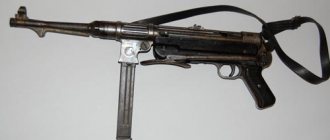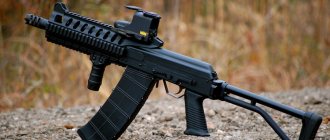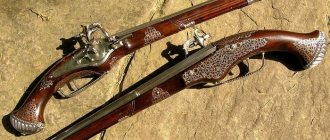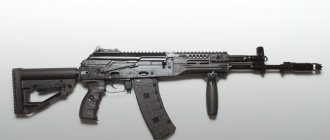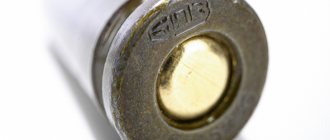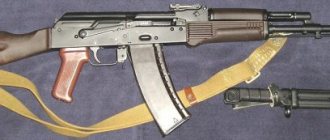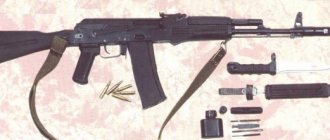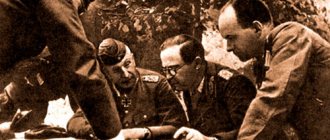The first samples of automatic rifles
The first samples of automatic rifles
The first idea to create automatic weapons belonged to the famous English metallurgist Heinrich Bessemer, who in 1854 took the privilege of automatic weapons. The first prototype of an automatic rifle was developed in America by Joseph Curtis in 1866.
More intensive work on the automatic rifle began to be carried out only after the Russo-Japanese War of 1904–1905, the experience of which raised the question of the need to increase the rate of fire of the weapon.
The first model that it was decided to adopt was the Mondragon rifle (Fig. 144), developed for the Mexican army, mod. 1907; caliber - 7 mm, number of cartridges in the magazine - 10, weight without bayonet - 4.12 kg. initial speed - 700 m/sec, target range - 2,000 m.
Rice. 144. Automatic rifle of the Mondragon system mod. 1907
Due to difficulties in setting up production, as well as due to the shortcomings of the rifle that emerged during wider testing, this decision was not implemented.
The next model adopted for service was the German Mauser assault rifle mod. 1910 (1913), caliber 7.9 mm. The number of cartridges in the magazine is 25, weight without bayonet is 4.8 kg. Shooting is possible only with lubricated cartridges. Before the war of 1914–1918, as well as during this war, several thousand Mauser assault rifles were manufactured, and they entered service mainly with airplanes; however, wider experience with their use did not give good results, and their production was discontinued.
It is further necessary to note the French automatic rifle mod. 1917 (Fig. 145).
Rice. 145. Automatic French rifle mod. 1917
The results of its use were also not entirely favorable, and therefore the French army undertook a number of studies regarding the further improvement of this weapon. In 1918, a new automatic rifle was adopted and subjected to extensive testing, with this model reportedly giving good results. Rifle caliber - 8 mm, weight without bayonet - 4.97 kg.
In 1918, the Browning assault rifle was adopted in the American army (Fig. 146); caliber - 7.62 mm, weight -7 kg, magazine - 20 and 40 rounds, maximum range - 1,460 m, initial speed - 823 m/sec.
Rice. 146. Automatic Browning system
.
However, extensive experience in using it among the troops did not produce favorable results; it was decided to improve it somewhat and, having given it a heavy barrel, transfer it to cavalry units in the form of a light machine gun.
Of the samples developed recently, the following should be noted.
Rifle mod. 1929, adopted in the former Czechoslovak army; caliber - 7.92 mm, weight - 4.285 kg, barrel length - 590 mm, magazines - 5, 10 and 20 rounds, initial speed - 820 m/sec (Fig. 147).
Rice. 147. Czechoslovakian automatic rifle 1929
Thomson machine guns and automatic rifles (Fig. 148) with a caliber of 7.71 mm, for English cartridges; magazines are designed for 5, 10 and 20 rounds, weight - 4.5 kg - light type and 6.8 kg - heavy type with a heavy barrel and bipod (automatic).
Rice. 148. Thomson automatic rifle
.
In 1936, the Garand rifle was adopted by the US Army; caliber -7.62 mm, weight with bayonet - 4.5 kg.
More intensive development of an automatic rifle began here, as well as abroad, after the Russo-Japanese War; at that time, V. Fedorov, V. Degtyarev, F. Tokarev, M. Roshchepey and others began to work in this direction. In 1907, V. Fedorov compiled our first course on automatic weapons. His automatic rifle, in the development of which the designer, now Hero of Socialist Labor V. Degtyarev, was directly involved, was subjected to the most detailed tests; the V. Fedorov system was developed for Russian, Japanese, as well as for new cartridges with improved ballistics, designed by V. Fedorov (Fig. 149).
Rice. 149. V. Fedorov’s assault rifle
.
The rifle passed all the required preliminary tests and in 1916 it was ordered in quantities of several thousand for the production of wider experiments with the new weapon among the troops.
For these experiments, a sample rifle chambered for the Japanese cartridge was chosen, since at that time all corps of the Northern Front were armed with Japanese Arisaka rifles, and Fedorov assault rifles were intended to be issued to these units; the sample chambered for the Japanese cartridge was more compact and lightweight.
The number of cartridges in the magazine is 25, the initial bullet speed is 660 m/sec, the rate is 600 rounds per minute, the practical rate of fire is 75-100 rounds when firing continuous fire with inserted magazines, weight is 4.4 kg.
Extensive testing of machine guns among the troops, however, did not give good results; the reasons were the complexity of the device and the resulting delays in feeding cartridges from magazines due to shortcomings in their manufacture.
In 1924, it was decided to announce a competition for the development of an automatic rifle for the Red Army, to which all the designers known at that time, who had proven themselves with their work on automatic weapons, were involved.
Competitive tests took place in 1926 and in the following years. The work of Soviet inventors for these competitions greatly advanced the development of a proper model of an automatic reel for the Red Army.
The October Socialist Revolution changed all the methods that had previously guided the arms industry and on which its further development and improvement depended. Design bureaus with trained personnel were organized to assist inventors in their work. Work invention has reached an unprecedented scale. The number of weapons designers has increased many times over. The personal attention and care of Comrade Stalin and Comrade Voroshilov inspire gunsmiths and help them work successfully.
Under current conditions and in the presence of such outstanding inventors of automatic rifles as V. Degtyarev, F. Tokarev and S. Simonov, the Red Army can, not without reason, be proud of the latest models of these weapons.
CONTENT
- 1 History 1.1 Mannlicher
- 1.2 Cei-Rigotti
- 1.3 Chauchat
- 1.4 Lewis gun
- 1.5 Fedorov Avtomat
- 1.6 Browning Automatic Rifle
- 1.7 ABC-36
- 1.8 FG 42
- 1.9 Sturmgewehr 44 (assault rifle)
- 1.10 AK-47
- Rifle 1.11 M14 (battle rifle)
- 1.12 FN FAL
- 1.13 H&K G3
- 1.14 M16 rifle
- 1.15 HK33
- 1.16 5.56 mm NATO
- 1.17 Steyr AUG (bullpup rifle)
D. A. Rudnitsky
In Russia, inventor D. A. Rudnitsky, back in 1887, presented to the officials of the Main Artillery Directorate a project for a self-firing rifle designed for firing in bursts, but received a negative conclusion.
French automatic rifle RSC model 1917. Length without bayonet - 1330mm, caliber - 8mm, weight without bayonet and cartridges - 5.2kg, rate of fire - 20 rounds per minute, effective firing range - 2400m, magazine capacity - 5 rounds.
SVT
By the way, the Soviet SVTs captured by the Germans were readily used by the Wehrmacht, assigning the index 453P - at that time Germany did not yet have such weapons. True, in 1941, units of the Nazi army began to receive rather cumbersome self-loading guns, manufactured by specialists and “Walter”, but they immediately revealed fatal shortcomings.
It got to the point that German soldiers exchanged them for old, but reliable and convenient Mauser “magazines”, and only by 1943 they managed to bring the Walther G-43(B) into acceptable condition and put it into production along with the sniper version.
Who actually invented the Kalashnikov assault rifle
Today, rumors are quite actively circulating among experts, especially “sofa” ones, that the Kalashnikov assault rifle was not developed by a Russian expert at all - they say, the model was simply copied from the German StG-44.
This rather persistent myth is worth dispelling. In general, it is enough to look at the disassembly diagram to understand that these two machines - Russian and German - despite their external similarity, have completely different structures.
Perhaps one of the main distinguishing features is the completely different way of locking the barrel - for automatic weapons this parameter is one of the most important. Thus, in a Kalashnikov assault rifle, the barrel locks the bolt, which rotates around the longitudinal axis. In the German analogue, the principle is completely different - here the shutter rotates in a vertical plane.
The layout is also different here. For example, on an AK, the trigger mechanism (also known as the trigger) is not removable, and the entire return mechanism is located in the receiver. Therefore, there is no need to remove the stock to disassemble the machine gun. The StG-44 is completely different. Here the recoil spring can only be removed by detaching the stock. At the same time, the trigger is also disconnected - it goes down along with the pistol grip.
There are a number of other, smaller differences, such as the design of the receiver, magazine mounts and others.
Therefore, we can say with confidence that despite the undoubted advantages of the German machine gun, the Soviet analogue not only surpasses it in all respects, but is also a completely independent model.
Our days
A modern automatic transmission is a well-oiled mechanism controlled by a special electronic unit. With the help of numerous sensors, the automatic transmission is able to control operating modes and display the necessary information on the screen of the car’s on-board computer.
5, 6, 7 and even 8-speed automatic transmissions were invented, which allow the driver to enjoy smooth acceleration and comfortable handling of a vehicle for any purpose:
- passenger cars;
- light trucks;
- SUVs;
- road and agricultural machinery;
- minibuses and full-size buses.
Servicing your automatic gearbox in specialized centers and using high-quality consumables and transmission fluids ensures its trouble-free operation for many years.
Over the course of several decades, the inventors of the automatic transmission and their many followers have been coming up with a new design and adapting this mechanism to modern human life. Even today, the development stage of automatic transmission cannot be called complete.
see also
Other weapons:
- Madsen machine gun
- Chauchat
- Fedorov Avtomat
- Farquhar Hill rifle
- Leichtes Maschinengewehr Modell 1925 "Lmg 25"
- Huot Automatic Rifle
- Morse submachine gun
- Knötgen automatic rifle
- Automatic rifle Zig
- Colt Automatic Rifle
- M27 Infantry Automatic Rifle
- Howell Automatic Rifle
- Rieder automatic rifle
- SIG SG 510
Other related articles:
- Semi-automatic rifle
- Assault rifle
- Combat rifle
- Marksman rifle
- Sniper rifle
- Light machine gun
- Squad automatic weapon
- List of firearms
The first car with automatic transmission
The classic automatic was first installed in a Buick production car in 1947. The next experimental cars were Cadillac and Pontiac. After many improvements and identification of transmission control shortcomings, the engineers of the American concern came up with an improved Hydra-Matic, which was equipped with numerous American and European brands:
- Mercedes-Benz;
- Bentley;
- Lincoln;
- Rolls-Royce;
- Kaiser;
- Hudson;
- Nash.
The first automatic cars sold like hotcakes, and by the end of the 60s no one could be surprised by the presence of a modern transmission. The creation of such a useful unit affected the driving style and lifestyle of motorists in general. After the automatic transmission was invented, driving a vehicle was easy and pleasant.
It was already common among wealthy people to buy their first car, equipped with an automatic transmission. A new generation of car enthusiasts has emerged who have never driven a manual transmission, but immediately got behind the wheel of a car with a modern transmission. Gradually, there were more and more such people in different countries.
Read
Diagram and device of planetary transmission of automatic transmission
Mauser Brothers Company
In Germany, similar systems were developed by the Mauser brothers. In 1898, when their repeating rifle was adopted, the Mausers also released an automatic rifle, which also had a middle magazine for 5 rounds, a sector sight, designed for firing at a distance of up to 2 thousand m, but was superior in rate of fire.
In it, powder gases acted on the barrel, which pushed the bolt back, compressing the spring; the latter immediately sent it back, and it, before engaging with the barrel, picked up the next cartridge. The trigger device was designed only for single shots. The automatic rifle never became a competitor to the “magazine” rifles - breakdowns and failures were too frequent.
At the end of the 19th - beginning of the 20th century
At the end of the 19th and beginning of the 20th centuries, they were designed by specialists and inventors from Great Britain, Germany, France, Denmark, Sweden, Austria-Hungary, the USA and Russia. However, the military did not immediately appreciate the new product, which, naturally, had enough “childhood diseases.”
For example, when using large-caliber cartridges, the mechanisms had to be strengthened, which affected the overall weight of the weapon. It turned out to be “voracious—the soldier spent two hundred rounds of ammunition in a matter of minutes, and mostly without aiming. Therefore, the automatic rifles that entered service were initially issued to the best shooters, who were distinguished by endurance and composure.
